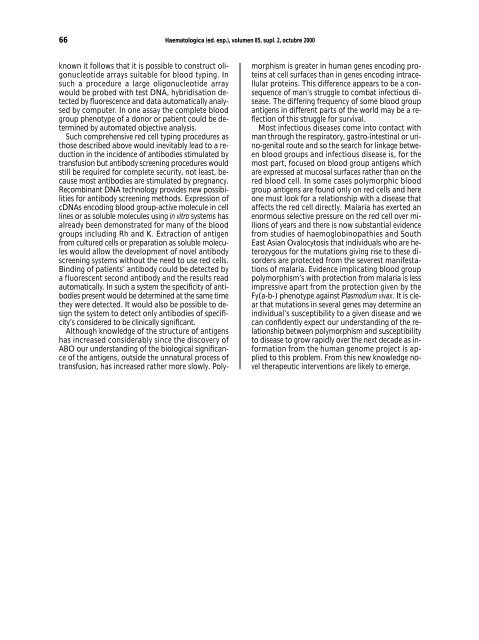Portada Simposios - Supplements - Haematologica
Portada Simposios - Supplements - Haematologica
Portada Simposios - Supplements - Haematologica
Create successful ePaper yourself
Turn your PDF publications into a flip-book with our unique Google optimized e-Paper software.
66 <strong>Haematologica</strong> (ed. esp.), volumen 85, supl. 2, octubre 2000<br />
known it follows that it is possible to construct oligonucleotide<br />
arrays suitable for blood typing. In<br />
such a procedure a large oligonucleotide array<br />
would be probed with test DNA, hybridisation detected<br />
by fluorescence and data automatically analysed<br />
by computer. In one assay the complete blood<br />
group phenotype of a donor or patient could be determined<br />
by automated objective analysis.<br />
Such comprehensive red cell typing procedures as<br />
those described above would inevitably lead to a reduction<br />
in the incidence of antibodies stimulated by<br />
transfusion but antibody screening procedures would<br />
still be required for complete security, not least, because<br />
most antibodies are stimulated by pregnancy.<br />
Recombinant DNA technology provides new possibilities<br />
for antibody screening methods. Expression of<br />
cDNAs encoding blood group-active molecule in cell<br />
lines or as soluble molecules using in vitro systems has<br />
already been demonstrated for many of the blood<br />
groups including Rh and K. Extraction of antigen<br />
from cultured cells or preparation as soluble molecules<br />
would allow the development of novel antibody<br />
screening systems without the need to use red cells.<br />
Binding of patients’ antibody could be detected by<br />
a fluorescent second antibody and the results read<br />
automatically. In such a system the specificity of antibodies<br />
present would be determined at the same time<br />
they were detected. It would also be possible to design<br />
the system to detect only antibodies of specificity’s<br />
considered to be clinically significant.<br />
Although knowledge of the structure of antigens<br />
has increased considerably since the discovery of<br />
ABO our understanding of the biological significance<br />
of the antigens, outside the unnatural process of<br />
transfusion, has increased rather more slowly. Polymorphism<br />
is greater in human genes encoding proteins<br />
at cell surfaces than in genes encoding intracellular<br />
proteins. This difference appears to be a consequence<br />
of man’s struggle to combat infectious disease.<br />
The differing frequency of some blood group<br />
antigens in different parts of the world may be a reflection<br />
of this struggle for survival.<br />
Most infectious diseases come into contact with<br />
man through the respiratory, gastro-intestinal or urino-genital<br />
route and so the search for linkage between<br />
blood groups and infectious disease is, for the<br />
most part, focused on blood group antigens which<br />
are expressed at mucosal surfaces rather than on the<br />
red blood cell. In some cases polymorphic blood<br />
group antigens are found only on red cells and here<br />
one must look for a relationship with a disease that<br />
affects the red cell directly. Malaria has exerted an<br />
enormous selective pressure on the red cell over millions<br />
of years and there is now substantial evidence<br />
from studies of haemoglobinopathies and South<br />
East Asian Ovalocytosis that individuals who are heterozygous<br />
for the mutations giving rise to these disorders<br />
are protected from the severest manifestations<br />
of malaria. Evidence implicating blood group<br />
polymorphism’s with protection from malaria is less<br />
impressive apart from the protection given by the<br />
Fy(a-b-) phenotype against Plasmodium vivax. It is clear<br />
that mutations in several genes may determine an<br />
individual’s susceptibility to a given disease and we<br />
can confidently expect our understanding of the relationship<br />
between polymorphism and susceptibility<br />
to disease to grow rapidly over the next decade as information<br />
from the human genome project is applied<br />
to this problem. From this new knowledge novel<br />
therapeutic interventions are likely to emerge.
















